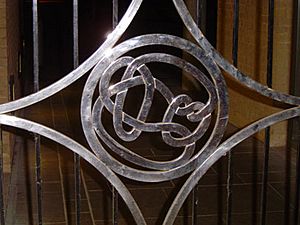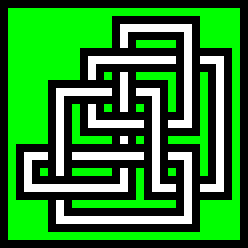Conway knot facts for kids
Quick facts for kids Conway knot |
|
|---|---|
 |
|
| Crossing no. | 11 |
| Genus | 3 |
| Conway notation | .-(3,2).2 |
| Thistlethwaite | 11n34 |
| Other | |
| prime, prime | |
The Conway knot is a special type of knot in mathematics, especially in an area called knot theory. It has 11 "crossings" when you draw it. This knot is named after a famous mathematician named John Horton Conway, who first described it.
Contents
What is a Knot in Math?
In everyday life, a knot is something like a tangled shoelace. In math, a knot is a closed loop of string that has been tangled up. Imagine a piece of string with its ends glued together. You can twist and turn it, but you can't cut it or pass it through itself. Knot theory is the study of these mathematical knots. Scientists study them to understand how they are different from each other.
Special Features of the Conway Knot
The Conway knot is interesting because it's related to another knot called the Kinoshita–Terasaka knot. They are connected by something called "mutation." This means you can change one part of the knot to get the other.
These two knots share some unique features:
- They have the same Jones polynomial. This is a special mathematical tool that helps tell knots apart.
- They also have the same Alexander polynomial and Conway polynomial. These are other mathematical tools that can describe a knot.
- What's really cool is that these polynomials are the same as those for the unknot. The unknot is just a simple circle with no tangles at all! This makes the Conway knot quite tricky to study.
Solving a 50-Year-Old Puzzle
For 50 years, mathematicians wondered if the Conway knot was a "slice knot." A slice knot is a knot that can be the boundary of a flat, disc-like surface in 4D space. Think of it like a knot that can be "unfolded" into a flat shape in a higher dimension.
In 2020, a mathematician named Lisa Piccirillo solved this long-standing puzzle. She proved that the Conway knot is not a "smoothly slice knot." This means it can't be unfolded smoothly. However, it is "topologically slice," which is a slightly different way of unfolding. The Kinoshita–Terasaka knot, on the other hand, is both smoothly and topologically slice. Lisa Piccirillo used a complex mathematical tool called Rasmussen's s-invariant to figure this out. Her discovery was a big deal in the world of knot theory!
See also
 In Spanish: Nudo Conway para niños
In Spanish: Nudo Conway para niños



